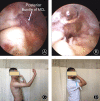Arthroscopic Treatment of Posttraumatic Elbow Stiffness Due to Soft Tissue Problems
- PMID: 33015918
- PMCID: PMC7670133
- DOI: 10.1111/os.12787
Arthroscopic Treatment of Posttraumatic Elbow Stiffness Due to Soft Tissue Problems
Abstract
Objectives: To evaluate the effectiveness of arthroscopic management of posttraumatic elbow stiffness due to soft tissue problems.
Methods: A retrospective review of 30 consecutive arthroscopic elbow releases for posttraumatic stiff elbow from November 2011 to December 2019 was conducted. Stiff elbows with bony problems, such as heterotopic ossification, intraarticular nonunion or malunion, and cartilage lesions were excluded from this study. Contracture and adhesion of soft tissue around the elbow were identified. Surgical treatments included arthroscopic capsulectomy, ligaments and muscle release, and ulnar nerve release. The results were evaluated using the Mayo elbow performance score (MEPS) and range of motion of the elbow. Surgery-related complications were assessed.
Results: Patients who underwent arthroscopic release were followed up for between 6 and 35 months, with a mean follow-up time of 10.1 months. The postoperative elbow ROM was 123.2° ± 19°, which was significantly different compared to the preoperative value of 68° ± 32°. In addition, the MEPS score improved from 71.2 ± 10.3 preoperatively to 93.7 ± 6.6 at the final follow-up, a mean improvement of 22.5 (range, 0-55; P < 0.05). Postoperative complications included five cases of prolonged drainage from the portal site, three transient nerve palsies, and one hematoma in the medial elbow.
Conclusion: With full recognition by the surgeon of the pathologic changes of the soft tissue around the elbow, arthroscopic release is usually safe and effective for posttraumatic elbow stiffness without symptomatic bony problems.
Keywords: Arthroscopic arthrolysis; Intra-articular adhesion; Posttraumatic elbow stiffness; Soft tissue contracture.
© 2020 The Authors. Orthopaedic Surgery published by Chinese Orthopaedic Association and John Wiley & Sons Australia, Ltd.
Figures




Similar articles
-
Heterotopic Ossification after Arthroscopic Elbow Release.Orthop Surg. 2020 Oct;12(5):1471-1477. doi: 10.1111/os.12801. Orthop Surg. 2020. PMID: 33200575 Free PMC article.
-
What Range of Motion and Functional Results Can Be Expected After Open Arthrolysis with Hinged External Fixation For Severe Posttraumatic Elbow Stiffness?Clin Orthop Relat Res. 2019 Oct;477(10):2319-2328. doi: 10.1097/CORR.0000000000000726. Clin Orthop Relat Res. 2019. PMID: 31107330 Free PMC article.
-
Arthroscopic arthrolysis for posttraumatic elbow stiffness.J Shoulder Elbow Surg. 2011 Apr;20(3):434-9. doi: 10.1016/j.jse.2010.11.018. J Shoulder Elbow Surg. 2011. PMID: 21397792
-
The assessment and management of the stiff elbow.Instr Course Lect. 2003;52:93-111. Instr Course Lect. 2003. PMID: 12690843 Review.
-
The posttraumatic stiff elbow: a review of the literature.J Hand Surg Am. 2007 Dec;32(10):1605-23. doi: 10.1016/j.jhsa.2007.09.015. J Hand Surg Am. 2007. PMID: 18070653 Review.
Cited by
-
Progression patterns of range of motion progression after open release for post-traumatic elbow stiffness.JSES Int. 2022 Feb 28;6(3):545-549. doi: 10.1016/j.jseint.2022.02.005. eCollection 2022 May. JSES Int. 2022. PMID: 35572429 Free PMC article.
-
Elbow Kinematics and Function Following Treatment with Open Arthrolysis and Hinged External Fixator.Orthop Surg. 2023 Aug;15(8):2102-2109. doi: 10.1111/os.13714. Epub 2023 Apr 13. Orthop Surg. 2023. PMID: 37052066 Free PMC article.
-
Shoulder and Elbow Surgery Special Issue.Orthop Surg. 2020 Oct;12(5):1337-1339. doi: 10.1111/os.12813. Orthop Surg. 2020. PMID: 33200573 Free PMC article. No abstract available.
-
A retrospective comparison of open and arthroscopic surgery for elbow joint stiffness; a single centre pragmatic study over 15 years.J Clin Orthop Trauma. 2025 Apr 23;66:103031. doi: 10.1016/j.jcot.2025.103031. eCollection 2025 Jul. J Clin Orthop Trauma. 2025. PMID: 40433654
-
Interpositional Arthroplasty With Dermal Grafting and Hinged External Fixator for Elbow Osteoarthrosis Associated With Stiffness in Young Adults.Cureus. 2025 Apr 4;17(4):e81723. doi: 10.7759/cureus.81723. eCollection 2025 Apr. Cureus. 2025. PMID: 40322364 Free PMC article.
References
-
- Morrey BF. The posttraumatic stiff elbow. Clin Orthop Relat Res, 2005, 431: 26–35. - PubMed
-
- Gallay SH, Richards RR, O'Driscoll SW. Intraarticular capacity and compliance of stiff and normal elbows. Art Ther, 1993, 9: 9–13. - PubMed
-
- Charalambos P, Morrey BF. Posttraumatic elbow stiffness. J Bone Joint Surg Am, 2012, 94: 1428–1437. - PubMed
-
- Morrey BF. Post‐traumatic contracture of the elbow. Operative treatment, including distraction arthroplasty. J Bone Joint Surg Am, 1990, 72: 601–618. - PubMed
-
- Jupiter JB, O'Driscoll SW, Cohen MS. The assessment and management of the stiff elbow. Instr Course Lect, 2003, 52: 93–111. - PubMed
MeSH terms
Grants and funding
- 2017ZZ01006/Limb Function Reconstruction Clinical Medicine Center
- shslczdzk05601/Shanghai Municipal Key Clinical specialty
- SHDC12018130/The foundation of systemic assessment of elbow dysfunction. Municipal Hospital Newly-developing Cutting-edge Technologies Joint Research Program of Shanghai Shenkang Hospital Development Center
- Shanghai Shenkang Hospital Development Center
LinkOut - more resources
Full Text Sources
Medical

